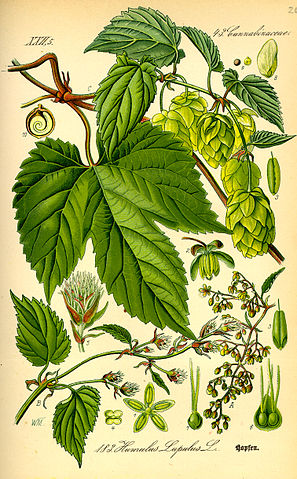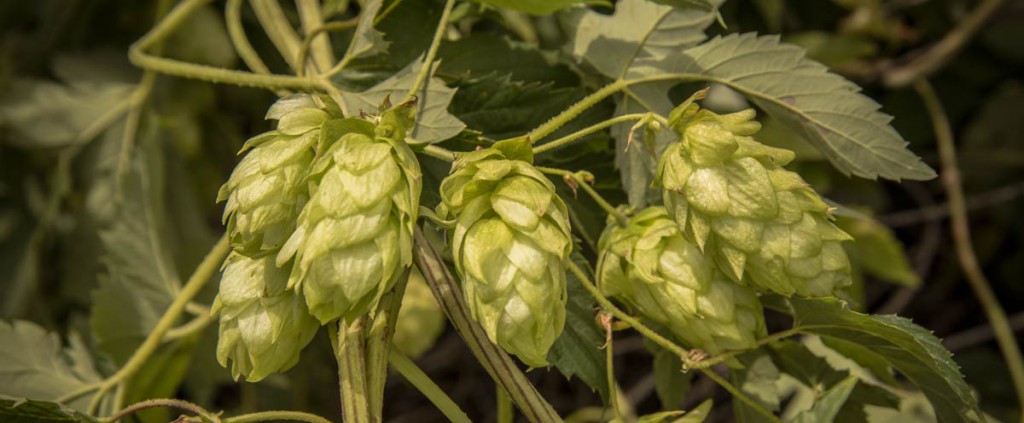Scientific Name: Humulus lupulus var. neomexicanus
Common Name: Common hop
Family: Cannabaceae
Article by Susan Bruneni
Humulus lupulus (common hop) is a species of flowering plant in the Cannabaceae family, native to Europe, Western Asia and North America. It has been used for food and medicinal purposes for centuries and is a fundamental flavoring and preserving ingredient in beer production. Our native species, Humulus lupulus var. neomexicanus, is now cultivated in Northern New Mexico for local beer brewer, Santa Fe Brewing Co.
It is a dioecious (male and female plants) perennial, herbaceous climbing plant that sends up new shoots in early spring and dies back to a cold-hardy rhizome in autumn. Hops are described as bine plants rather than vines because, unlike vines, they have stiff, downward facing hairs that provide stability and allow them to climb. These shoots allow H. lupulus to grow anywhere from 15-20 feet. Hops have fragrant, wind -pollinated flowers that attract butterflies.
Common hop was mentioned by Pliny in 77 CE. He commented that Romans used to eat the young shoots like asparagus “chopped very fine with butter or cream.” Cultivation of H. lupulus is first mentioned in 768 CE, when King Pepin, King of Italy, donated hops to a monastery in Paris. Cultivation was also recorded in 859 CE, in documents from a German monastery. Many medicinal uses of the plant are found throughout its growing areas.
Leonora Curtin indicated the importance of H. lupulus var. neomexicana in Healing Herbs of the Upper Rio Grande. She says, “These cones, in olden times, were taken internally as a decoction, since they were supposed to exert a powerful sedative and hypnotic action without the bodily disorders caused by opium, and an ancient custom, formerly w idely practiced, was to sleep on a pillow stuffed with hops as a means of obtaining sleep.” She mentions a number of other uses in Northern New Mexico (Page 199).
idely practiced, was to sleep on a pillow stuffed with hops as a means of obtaining sleep.” She mentions a number of other uses in Northern New Mexico (Page 199).
The female cone-shaped fruits from H. lupulus are used by breweries to preserve and flavor beer. The fragrant flower cones, known as hops, impart a bitter flavor, and also have preservative qualities. The genus name, humulus, is a Medieval name that was Latinized, while lupulus is Latin for small wolf, referring to the plant’s tendency to strangle other plants, mainly willows, like a wolf strangles a sheep. The English word hop is taken from the Anglo- Saxon word hoppan meaning to climb. Hops are susceptible to hop leaf aphid, red spider mite, Japanese beetle and mildew.
Hops are currently cultivated in the United States, Germany, England, France, South Russia, Australia and New Zealand. According to its website, “Santa Fe Brewing Company embraces a farm-to-table type approach to brewing whenever possible. So in 2013, we started a hop farm in Rinconada, New Mexico right alongside the Rio Grande. Here, four varieties of estate-grown hops are being harvested and used in one wet hop beer brewed every fall. One variety, Neomexicanus, is a wild hop indigenous to Northern New Mexico and one of the only native North American hops suitable for brewing.” (Wet hop is not dried and then used, but harvested and used immediately.)
References:
Healing Herbs of the Upper Rio Grande
Wikipedia
http://climbers.lsa.umich.edu
santafebrewing.com




